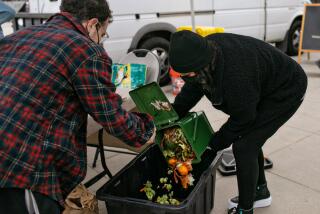How about preserving that bounty of tomatoes? Can do.
- Share via
Chef Ernie Miller doesn’t hesitate when asked what to do with the end-of-season bounty that’s too good to toss and too plentiful to use, such as tomatoes, squash and herbs.
“For the tomatoes, I recommend canning,” says Miller, who besides being a chef is also a University of California-certified master gardener as well as a master preserver.
The initial cost of $25 to $30 for equipment is quickly repaid in having home-grown tomatoes to use in January. He advises taking a basic canning course or checking out the National Center for Home Food Preservation (nchfp.uga.edu/) for tips and recipes.
He’s also a fan of dehydration. Hang bundles of thyme, tarragon and other herbs in the shade outside for a few days; oven-dry tomatoes or squash overnight at under 140 degrees Fahrenheit, about the temperature of a gas oven with a pilot.
“Having a collection of dehydrated tomatoes is fantastic. When I make my soups and marinaras, I’ll toss those dehydrated tomatoes in there and it’s like adding tomato paste — it concentrates the tomato flavor.”
Dried zucchini can be grated into a powder to use as a garnish or flavoring, he adds.
Pickling in pure salt or vinegar works for citrus, radishes, cabbages, cucumbers, turnips, green tomatoes and even green beans.
An abundance of basil can be processed into pesto and frozen as ice cubes to later accent soups and sauces. Likewise, mint can be made into cubes: Blend it with just enough water to make a paste and freeze in an ice cube tray.
“You can toss them in any beverage you want to make — even water.”
More to Read
Eat your way across L.A.
Get our weekly Tasting Notes newsletter for reviews, news and more.
You may occasionally receive promotional content from the Los Angeles Times.










